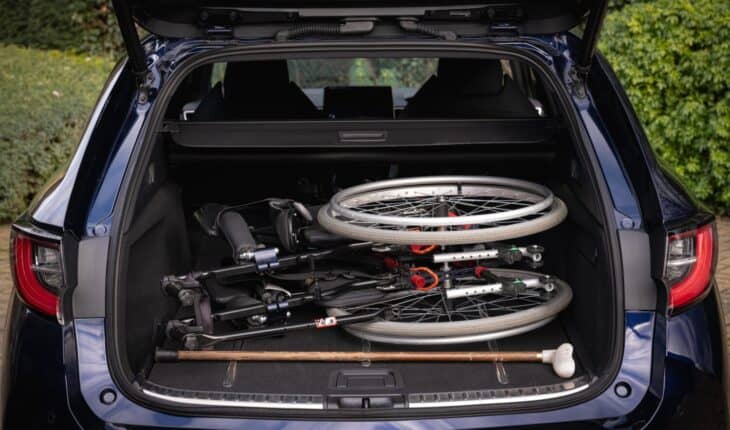Driving is a great way to be independent, enabling us to connect with other people, take part in social events, or travel to work. But for people with mobility issues there can be times when it is a challenge to get into, or out of, a car. As part of Toyota’s mission to achieve better mobility for all, the company has teamed up with the Royal College of Occupational Therapists (RCOT) to put together some tips to help.
Karin Orman, RCOT Director of Practice and Innovation, says: “If someone has mobility issues – perhaps an older person who is becoming frail or who has had a fall, or someone who has had recent surgery – getting into and out of a car can prove to be a challenge, making them reluctant to travel. Fortunately, there are lots of simple ideas and adjustments to help people of all ages and with a range of conditions, to overcome these difficulties. As occupational therapists we can provide advice to help you live your best life.”
Toyota spent a day with two occupational therapists, Natasha May Powell, an Advance Occupational Therapist Practitioner, and Charan Chana, a Senior Occupational Therapist with Central and North West London NHS Trust, and with John Healy, from Virginia Water, who uses a walking stick, a walker or a mobility scooter. Natasha May and Charan demonstrated ways of helping John to get into and out of two different size cars: a Toyota Aygo X, and a Corolla Touring Sports.
Making adjustments
Modern cars like the Toyota Aygo X and Corolla Touring Sports are simple to adjust to make access easier and safer for passengers and driver, and ensure a comfortable and safe car journey, especially for someone with restricted mobility.
- Move the seat back as far as it will go to create more space. This is particularly useful for people with knee issues, or with prosthetic limbs.
- Adjust the seat belts so they are in the best position for comfort and safety.
- Drivers can also adjust the steering column to an optimum position.
Transporting equipment
- Natasha May advises: “Before a journey it helps to identify how to transport mobility equipment, thinking about where it might fit in the car or boot, to make access easier and safer. See if you can fold the equipment down or take it apart; that way it won’t be so heavy to lift and will be easier to store.”
- If you’re using the boot, put a blanket down first; it’ll create a smoother surface and make it easier to slide equipment in and out.
- Before you get in the car, store your walking stick in the back, so it doesn’t interfere with the pedals.
Getting in and out of vehicles
- When getting into a car, work out the safest place to put your hands to provide support. Instead of balancing on a walking frame, you could use the frame of the car, or roof-mounted grab handles. Alternatively, you might want to consider getting a portable door handle (sometimes known as a bunny handle). This provides a secure hand hold and when not in use fits neatly into the glove compartment or door pocket.
- Get into a car bottom first. This helps keep both feet on the floor until you’re sitting down and means you’re less likely to stumble or fall.
- Once sitting down, you can use a swivel cushion to help you get into the right position – but if you don’t have one, a plastic bag works well too.
- A leg lifter can help get legs over the sill of the car. If you don’t have one, a dressing gown cord, or something like a yoga strap, is just as good.
- Cars come in different shapes and sizes and the height, whether it’s low or high, can cause problems. If a car is too high, using a step could help – but make sure it’s on a flat surface and be mindful of weather conditions. If a car is low, park the car on a flat surface; don’t park by a kerb as it will make the situation worse, and use the ‘bottom first’ technique.
- Try not to use a frame to get into and out of the car as the surface may be unstable.
Parking
- Charan comments: “When choosing a suitable parking spot, identify potential hazards to avoid difficulties when getting in or out of the car. Make sure there is enough room to open the door fully so that the driver and passenger can both get out easily, and safely retrieve any mobility aids.”
- Try to park on a level surface, as uneven surfaces, like grass, can make getting in and out more difficult and potentially dangerous.
Preparing for long journeys
- If you’re going on a long journey, think about how you can break it down into more manageable chunks – both for the driver and the passenger.
- Plan breaks where you can have a rest and rehydrate. This is particularly important for someone with a health condition where they become tired.
After the demonstration, John Healy said: “I will definitely be putting all the tips into practice, particularly the bunny handle and the dressing gown tie, which I wasn’t previously aware of. It’s removed some concerns about my mobility when leaving the house, giving me so much more freedom to carry on doing all the things I love, without being restricted to the house.”
Natasha May said: “These simple and effective ways to access a car can completely change the life of you, or someone you are helping who has mobility issues. It increases independence and brings a new purpose and meaning into their life, which they may have lost due to concerns and anxieties about leaving the house.”
- New lipid-based pathway discovered as key to memory formation - 25th June 2025
- Crucial link could explain how Alzheimer’s takes hold - 25th June 2025
- Understanding Your Mind Can Improve Daily Life - 25th June 2025







